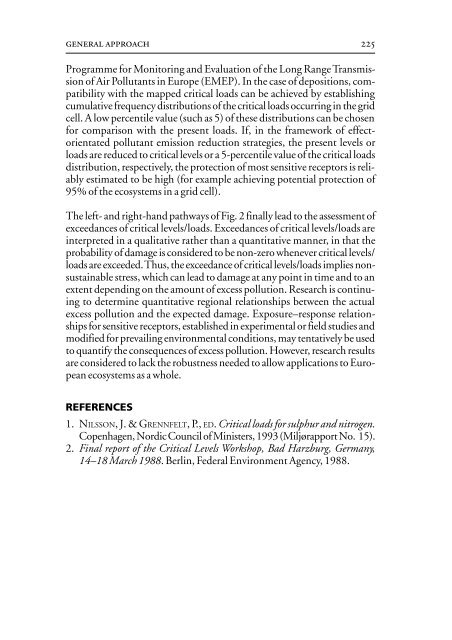Air Quality Guidelines - World Health Organization Regional Office ...
Air Quality Guidelines - World Health Organization Regional Office ...
Air Quality Guidelines - World Health Organization Regional Office ...
You also want an ePaper? Increase the reach of your titles
YUMPU automatically turns print PDFs into web optimized ePapers that Google loves.
general approach<br />
225<br />
Programme for Monitoring and Evaluation of the Long Range Transmission<br />
of <strong>Air</strong> Pollutants in Europe (EMEP). In the case of depositions, compatibility<br />
with the mapped critical loads can be achieved by establishing<br />
cumulative frequency distributions of the critical loads occurring in the grid<br />
cell. A low percentile value (such as 5) of these distributions can be chosen<br />
for comparison with the present loads. If, in the framework of effectorientated<br />
pollutant emission reduction strategies, the present levels or<br />
loads are reduced to critical levels or a 5-percentile value of the critical loads<br />
distribution, respectively, the protection of most sensitive receptors is reliably<br />
estimated to be high (for example achieving potential protection of<br />
95% of the ecosystems in a grid cell).<br />
The left- and right-hand pathways of Fig. 2 finally lead to the assessment of<br />
exceedances of critical levels/loads. Exceedances of critical levels/loads are<br />
interpreted in a qualitative rather than a quantitative manner, in that the<br />
probability of damage is considered to be non-zero whenever critical levels/<br />
loads are exceeded. Thus, the exceedance of critical levels/loads implies nonsustainable<br />
stress, which can lead to damage at any point in time and to an<br />
extent depending on the amount of excess pollution. Research is continuing<br />
to determine quantitative regional relationships between the actual<br />
excess pollution and the expected damage. Exposure–response relationships<br />
for sensitive receptors, established in experimental or field studies and<br />
modified for prevailing environmental conditions, may tentatively be used<br />
to quantify the consequences of excess pollution. However, research results<br />
are considered to lack the robustness needed to allow applications to European<br />
ecosystems as a whole.<br />
REFERENCES<br />
1. NILSSON, J. & GRENNFELT, P., ED. Critical loads for sulphur and nitrogen.<br />
Copenhagen, Nordic Council of Ministers, 1993 (Miljørapport No. 15).<br />
2. Final report of the Critical Levels Workshop, Bad Harzburg, Germany,<br />
14–18 March 1988. Berlin, Federal Environment Agency, 1988.

















